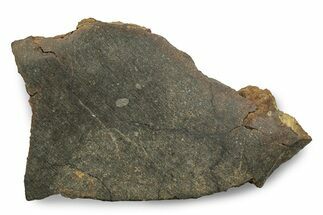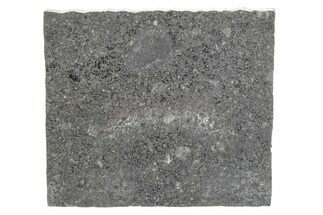6.64" H4 Chondrite Meteorite (279.1 g) Slice - NWA 11700
This is a 6.64" wide (279.1 gram) slice of the NWA 11700 ordinary chondrite (H4) meteorite. It has been cut flat on both sides to highlight the densely packed grains.
Comes with an acrylic display stand.
Comes with an acrylic display stand.
About the NWA 11700 Meteorite
NWA 11700 was discovered in Northwest Africa in 2017 and was sold in November of the same year to Adam Aaronson. It's classified as an H4 ordinary chondrite with closely packed, well-formed, relatively small chondrules, set in a recrystallized matrix containing altered kamacite and merrillite. The total mass of this meteorite is 102.3 kg.
Meteoritical Bulletin: Entry for The NWA 11700 Meteorite
NWA 11700 was discovered in Northwest Africa in 2017 and was sold in November of the same year to Adam Aaronson. It's classified as an H4 ordinary chondrite with closely packed, well-formed, relatively small chondrules, set in a recrystallized matrix containing altered kamacite and merrillite. The total mass of this meteorite is 102.3 kg.
Meteoritical Bulletin: Entry for The NWA 11700 Meteorite
About Chondrites
Chondrites are stony (non-metallic) meteorites that have not been modified by either melting or differentiation of the parent body. They are formed when various types of dust and small grains in the early Solar System accreted to form primitive asteroids. Some such bodies are captured in the planet’s gravity well and pulled to the surface. They are by far the most common type of meteorite, representing about 86 percent of all meteorites that have fallen to Earth.
Prominent among the components present in chondrites are the enigmatic chondrules, millimeter-sized spherical objects that originated as freely floating, molten or partially molten droplets in space; most chondrules are rich in the silicate minerals olivine and pyroxene. Chondrites also contain particles of various metals such as nickel, iron, and aluminum. These formed at the very beginning of the solar system and aggregated over time: they are the oldest rocks known on Earth!
Chondrites are divided into about fifteen distinct groups on the basis of their mineralogy, bulk chemical composition, and oxygen isotope compositions. The various chondrite groups likely originated on separate asteroids or groups of related asteroids. Each chondrite group has a distinctive mixture of chondrules, refractory inclusions, matrix (dust), characteristic chondrule sizes, and other components. Other ways of classifying chondrites include weathering and shock. The L chondrite group is the most common of these.
Chondrites are stony (non-metallic) meteorites that have not been modified by either melting or differentiation of the parent body. They are formed when various types of dust and small grains in the early Solar System accreted to form primitive asteroids. Some such bodies are captured in the planet’s gravity well and pulled to the surface. They are by far the most common type of meteorite, representing about 86 percent of all meteorites that have fallen to Earth.
Prominent among the components present in chondrites are the enigmatic chondrules, millimeter-sized spherical objects that originated as freely floating, molten or partially molten droplets in space; most chondrules are rich in the silicate minerals olivine and pyroxene. Chondrites also contain particles of various metals such as nickel, iron, and aluminum. These formed at the very beginning of the solar system and aggregated over time: they are the oldest rocks known on Earth!
Chondrites are divided into about fifteen distinct groups on the basis of their mineralogy, bulk chemical composition, and oxygen isotope compositions. The various chondrite groups likely originated on separate asteroids or groups of related asteroids. Each chondrite group has a distinctive mixture of chondrules, refractory inclusions, matrix (dust), characteristic chondrule sizes, and other components. Other ways of classifying chondrites include weathering and shock. The L chondrite group is the most common of these.
$395
TYPE
Ordinary Chondrite (H4)
AGE
LOCATION
Northwest Africa
SIZE
6.64 x 5.51 x .17", 279.1 gram
CATEGORY
ITEM
#301184
 Reviews
Reviews









